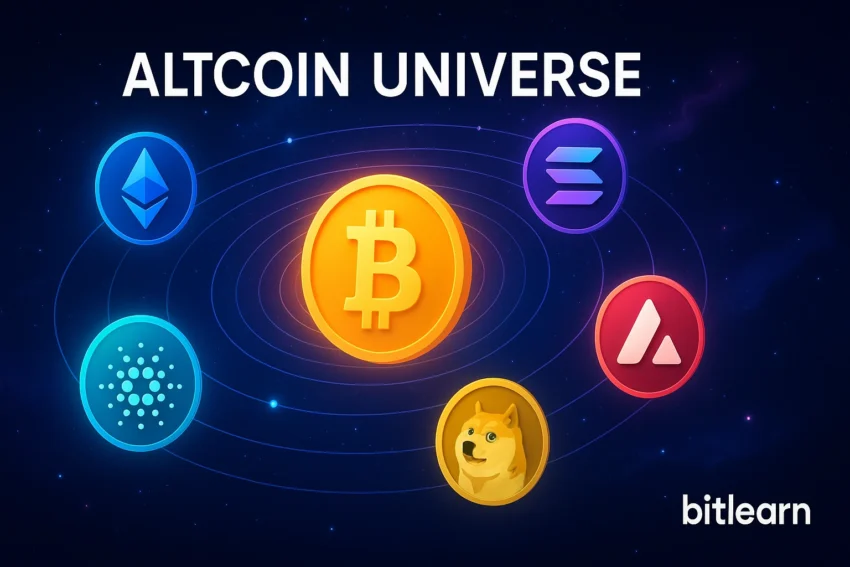For many new entrants into the cryptocurrency space, the journey begins and ends with Bitcoin. As the original and largest cryptocurrency, it dominates the headlines and serves as the market’s benchmark.
However, the world of digital assets is a vast and diverse universe, comprising thousands of alternative cryptocurrencies, or “altcoins,” each with its own unique technology, use case, and community. While investing in altcoins carries significantly higher risk than investing in established assets like Bitcoin, it also offers the potential for outsized returns.
For traders looking to expand their horizons in 2025, understanding the different categories of altcoins and how to evaluate them is a crucial next step.
Layer-1 protocols: The contenders for the throne
The most significant category of altcoins is “Layer-1” (L1) protocols. These are foundational blockchains that, like Bitcoin and Ethereum, are designed to be the base layer of a new, decentralized internet. Projects like Solana, Cardano, and Avalanche are all competing to become the next dominant smart contract platform, each offering a different approach to solving the “blockchain trilemma” of balancing scalability, security, and decentralization. Investing in an L1 token is a bet on the future success of that entire ecosystem.
When evaluating an L1, traders look at factors like transaction speed, transaction costs, the size of its developer community, and the number of decentralized applications (dApps) being built on its platform. A deep dive into the technology and the ecosystem is a form of Fundamental Analysis that is essential for making an informed investment decision in this competitive space.
DeFi Tokens: The financial plumbing of Web3
Decentralized Finance (DeFi) has been one of the most explosive growth areas in crypto. DeFi protocols are building a new, open, and permissionless financial system on the blockchain, offering services like lending, borrowing, and decentralized exchange. Each of these protocols typically has its own “governance token.”
Holders of these tokens can vote on proposals that shape the future of the protocol, such as adjusting interest rates or allocating treasury funds. In many cases, these tokens also capture a portion of the revenue generated by the protocol. Investing in a DeFi token is a bet on the continued growth and adoption of that specific financial application. The DeFi space is vast, covering dozens of different markets from derivatives to insurance.
The world of memecoins and micro-caps
At the highest-risk end of the altcoin spectrum are “memecoins.” These are cryptocurrencies, like Dogecoin or Shiba Inu, whose value is derived almost entirely from community hype, social media trends, and viral marketing, rather than any underlying technology or utility. Investing in memecoins is akin to pure speculation, as their prices are subject to extreme volatility and can collapse as quickly as they rise.
While some early investors have made life-changing gains, the vast majority of people who buy into the hype end up losing money. Navigating this corner of the market requires an iron-clad understanding of market psychology and a disciplined approach to risk. The emotional roller coaster of memecoin trading is a stark illustration of the principles outlined in education on Trading Psychology and Risk Management.
Building a diversified altcoin portfolio
Given the high risks involved, a prudent approach to altcoin investing requires significant diversification. A well-balanced crypto portfolio might have a large allocation to established assets like Bitcoin and Ethereum, a smaller allocation to promising Layer-1 and DeFi protocols, and, for those with a very high risk tolerance, a tiny allocation to more speculative plays. Managing such a portfolio requires a versatile and secure trading platform.
A broker that offers a wide range of digital assets, alongside robust security features and a variety of account types, provides the necessary infrastructure for navigating the complexities of the altcoin universe. Platforms like the YWO trading platform are built for this purpose, allowing traders to construct and manage a diversified digital asset portfolio from a single, trusted environment.

Vanna Berkey is a young, ambitious woman who has a passion for blockchain technology and cryptography. She has been working in the cryptocurrency industry since she was 18 years old, and is an expert in blockchain algorithms. Vanna is determined to use her knowledge and skills to make a positive impact on the world.

